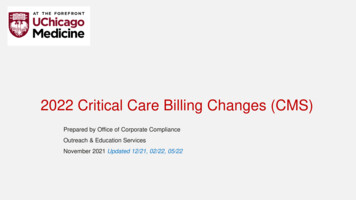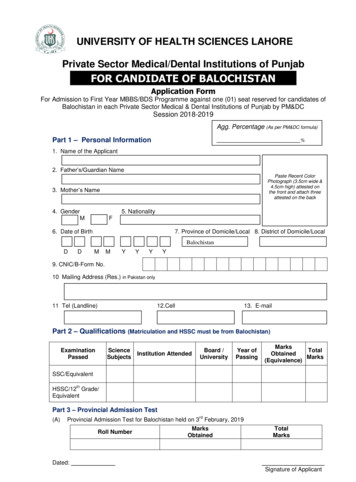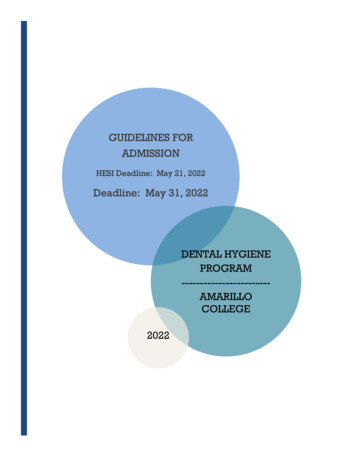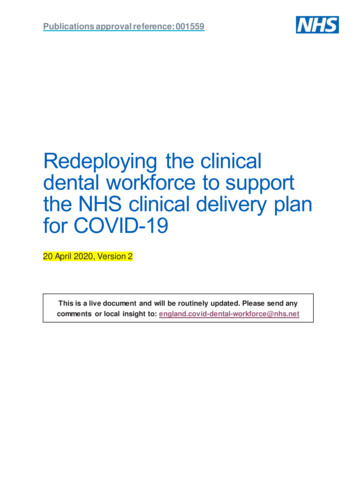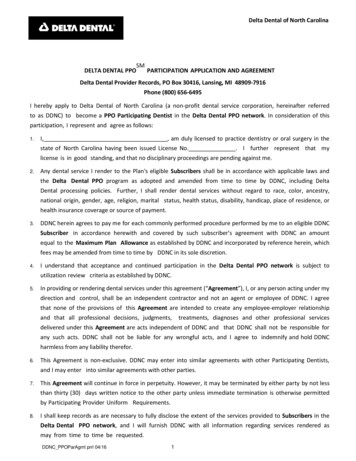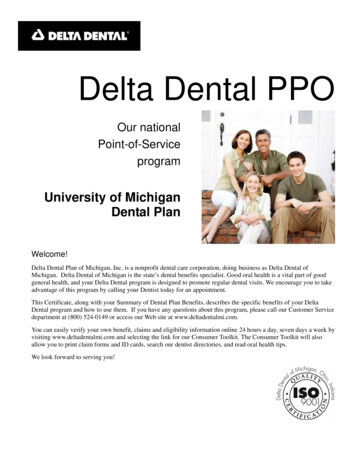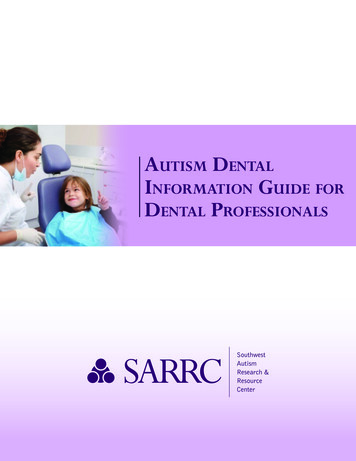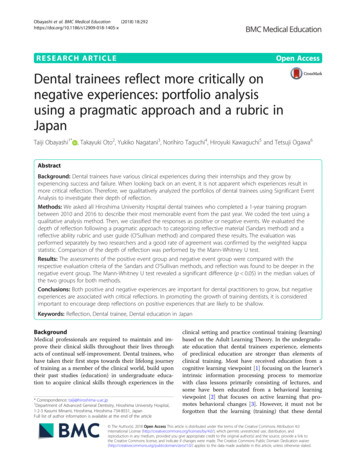
Transcription
Obayashi et al. BMC Medical Education(2018) EARCH ARTICLEOpen AccessDental trainees reflect more critically onnegative experiences: portfolio analysisusing a pragmatic approach and a rubric inJapanTaiji Obayashi1* , Takayuki Oto2, Yukiko Nagatani3, Norihiro Taguchi4, Hiroyuki Kawaguchi5 and Tetsuji Ogawa6AbstractBackground: Dental trainees have various clinical experiences during their internships and they grow byexperiencing success and failure. When looking back on an event, it is not apparent which experiences result inmore critical reflection. Therefore, we qualitatively analyzed the portfolios of dental trainees using Significant EventAnalysis to investigate their depth of reflection.Methods: We asked all Hiroshima University Hospital dental trainees who completed a 1-year training programbetween 2010 and 2016 to describe their most memorable event from the past year. We coded the text using aqualitative analysis method. Then, we classified the responses as positive or negative events. We evaluated thedepth of reflection following a pragmatic approach to categorizing reflective material (Sandars method) and areflective ability rubric and user guide (O’Sullivan method) and compared these results. The evaluation wasperformed separately by two researchers and a good rate of agreement was confirmed by the weighted kappastatistic. Comparison of the depth of reflection was performed by the Mann-Whitney U test.Results: The assessments of the positive event group and negative event group were compared with therespective evaluation criteria of the Sandars and O’Sullivan methods, and reflection was found to be deeper in thenegative event group. The Mann-Whitney U test revealed a significant difference (p 0.05) in the median values ofthe two groups for both methods.Conclusions: Both positive and negative experiences are important for dental practitioners to grow, but negativeexperiences are associated with critical reflections. In promoting the growth of training dentists, it is consideredimportant to encourage deep reflections on positive experiences that are likely to be shallow.Keywords: Reflection, Dental trainee, Dental education in JapanBackgroundMedical professionals are required to maintain and improve their clinical skills throughout their lives throughacts of continual self-improvement. Dental trainees, whohave taken their first steps towards their lifelong journeyof training as a member of the clinical world, build upontheir past studies (education) in undergraduate education to acquire clinical skills through experiences in the* Correspondence: taiji@hiroshima-u.ac.jp1Department of Advanced General Dentistry, Hiroshima University Hospital,1-2-3 Kasumi Minami, Hiroshima, Hiroshima 734-8551, JapanFull list of author information is available at the end of the articleclinical setting and practice continual training (learning)based on the Adult Learning Theory. In the undergraduate education that dental trainees experience, elementsof preclinical education are stronger than elements ofclinical training. Most have received education from acognitive learning viewpoint [1] focusing on the learner’sintrinsic information processing process to memorizewith class lessons primarily consisting of lectures, andsome have been educated from a behavioral learningviewpoint [2] that focuses on active learning that promotes behavioral changes [3]. However, it must not beforgotten that the learning (training) that these dental The Author(s). 2018 Open Access This article is distributed under the terms of the Creative Commons Attribution 4.0International License (http://creativecommons.org/licenses/by/4.0/), which permits unrestricted use, distribution, andreproduction in any medium, provided you give appropriate credit to the original author(s) and the source, provide a link tothe Creative Commons license, and indicate if changes were made. The Creative Commons Public Domain Dedication o/1.0/) applies to the data made available in this article, unless otherwise stated.
Obayashi et al. BMC Medical Education(2018) 18:292trainees will undergo through clinical experiences in thelifelong journey of training will mainly consist of theconstructivist learning viewpoint [4, 5] of learningthrough reflection amidst interactions with society (experience pertaining to skills and encounters) [6–8] andthe legitimate peripheral participation learning viewpoint[9, 10] of learning through collaboration with others as amember of the clinical setting, rather than the aforementioned cognitive and behavioral learning viewpoint[11]. The legitimate peripheral participation learningviewpoint is a learning viewpoint in which novices whoat first can be positioned only in the periphery in workplaces and other social settings come to participate appropriately through learning from senior members andother means and come to acquire a position as a fullmember of that community.As a reflective practitioner, medical professionals requirethe ability to reflect in order to maintain continualself-improvement [12, 13]. Knowledge accumulation andthe cognitive placement of meaning (constructivist learning viewpoint) through reflection after action promotesreflection for the next action, and this leads to theself-improvement for acquiring, maintaining, and improving clinical skills [14, 15]. This is the continuation of reflective practice. By undergoing a specific experience andreflectively observing this experience, one makes ageneralization within him/herself (“generalization” hererefers to meticulously creating “my theory” that is understood only by oneself rather than a concept that is generally understood). “My theory” refers to clinical pearls,techniques, one’s own standards and similar factors. This“my theory” is put into practice and the individual undergoes a new experience and subsequently reflects on thisexperience, and the cycle repeats. Many unexpectedevents are encountered in clinical settings, and there arethings that an individual cannot deal with using his or herpresent “my theory.” However, a person cannot run awayfrom a situation simply because it is unexpected. Doctorsmobilize their accumulated knowledge and experiencesand attempt to somehow get through the situation. Theseries of reflections performed to do this is called “reflection in action.” Looking back on the situation after it hasended is called “reflection on action,” and a new “my theory” is derived from that reflection. The crucial point ishow the experience was interpreted and what kind of information was gained through the experience, rather thanthe experience itself [16]. In other words, even if multiplepeople undergo the exact same experience, the learningand subsequent actions differ if the interpretation of theexperience differs [17]. As described, experience andlearning are concepts that are linked closely and cannotbe separated [18], and reflection plays a key role withinthis process. On the other hand, Moon, who developed amethod to analyze and evaluate the depth of reflectionPage 2 of 8from the level and content of critical thinking, reportedthat critical reflections are closely tied to the acquisitionand fostering of clinical skills [19]. Critical reflection asdefined by Moon is demonstrating “an awareness that action and events are not only located within and explicableby multiple perspectives, but are located in and influencedby multiple historical and socio-political contexts.” This isstrongly associated with expanding the range of andenriching “my theory” and the depth of reflection.The importance of reflection has been increasing inmedical education, and Sandars stated that reflection isan essential aspect of medical education [20]. Onishi etal. proposed a method from a learning strategy viewpoint to promote reflection by introducing SignificantEvent Analysis (SEA) [21]. With regard to reflection inmedical education, prior studies have shown that thatReflective ability scores are higher in students who areprovided critical reflection guidelines in advance [22],online reflection writing accompanying feedback improves resident learning [23], and feedback from closerelatives and non-medical professionals has positive effects on reflection in medical students’ portfolios [24].Furthermore, students who exhibit unprofessional behavior have low reflective ability [25].The training environment of dental trainees affects reflective ability scores [26], and reflective practice interventions in medical care have huge advantages forindividual learners, such as making relationships favorable with instructors [27]. Therefore, the Hiroshima University Hospital [28] uses a portfolio for structuralreflection as a systematic training tool for postgraduateclinical training for dentists.In this study, to develop an educational approach andassessment index of critical and deep reflection abilities,we investigated the aspects of reflection in dentaltrainees who took their first steps towards becoming amedical professional using a portfolio (SEA).MethodsThree-hundred and thirty-three dental trainees at Hiroshima University Hospital from FY2010 to FY2016 wereasked at the end of the 1-year training (immediately following the graduation ceremony) to reflect on the pastyear and describe the most memorable event. AnA4-size paper was distributed with the question “Whatwas the most memorable event from this past year?Please describe it in your own words below. You canchoose to write about anything. There is no word limit.Please describe the event so that it is easy for us tounderstand why you specifically chose to write aboutthis event.” Although this was conducted after graduation, the trainees were reassured verbally that the questionnaire response would not affect their trainingevaluation at all and will not be used for purposes other
Obayashi et al. BMC Medical Education(2018) 18:292than research. The questionnaire was collected on thesame day. The 7 years of data were coded using Stepsfor Coding and Theorization [29, 30], and concepts werecategorized based on the obtained themes and constructs, storyline, and theoretical descriptions. Furthermore, these were categorized into positive events (PEgroup), negative events (NE group), and neutral events.PE corresponded to descriptions of a happy event, andNE corresponded to a sad or tough event.The evaluation of a portfolio containing qualitativedata requires a different approach than traditional quantitative methods, and the use of rubrics is known to beeffective [31]. The depth of reflection was evaluated withthe Sandars method [20] and the O’Sullivan method[32]. The former classifies the depth of reflection intosix categories (Grade A through F) and is scored inone-point increments from 0 points for Grade F withthe shallowest reflection to 5 points for Grade A withthe deepest reflection. For the latter classification, theoriginal point system (0 points for the shallowest reflection and 6 points for the deepest reflection) was used.The Sandars method is a modified version of Moon’sfour-level assessment [19] and is evaluated on six levelsfor enhanced practicality (Table 1). The criteria are morespecific in the modified version than in Moon’s assessment and are easier to use. On the other hand, themodified version has features in which descriptions involving decisions are scored high even if personal interpretation dictates the decision. O’Sullivan’s method usesa seven-level assessment and is an amended version ofthe scoring schema that was used at the Centre for Medical Education at the University of Dundee for evaluatingreflection of a portfolio (Table 2). The rubric, which specifies the scoring criteria, detailed criteria, and examplesentences for each level, was created based on multiplepsychometric studies. A study on reflection that usedthis rubric has been reported [23], demonstrating its reliability and validity. The scoring criteria are easy toTable 1 Scores of Reflection Measured by the Sandars methodScoreScoring Guidelines0 - (Grade F) Describing an event – poor description of an event.1 - (Grade E) Describing an event – repeating the details of an eventwithout offering any interpretation.2 - (Grade D) Describing an event – recognising that something isimportant but not explaining why.3 - (Grade C) Describing an event – recognising how it affects yourfeelings, attitudes and beliefs and/or questioning whathas been learnt and comparing it to previous experience.4 - (Grade B) Involves judgement – what went well, or less well and why.5 - (Grade A) Experiencing an event(s) has changed, or confirmed, howyou experience an event(s). You may wish to changehow you respond to similar event(s in the future. Youprovide an explanation, including references to otherliterature, eg articles or books.Page 3 of 8Table 2 Level of Reflection Measured by the O’Sullivan methodLevelReflection Performance0Does not respond to the assignment1Describes without reflecting2Does not justify lessons learned3Provides limited justification of lessons learned4Includes evidence of lessons learned5Analyzes factors from experience6Integrates previous experience with currentevents and data to inform further actionunderstand. Specifically, to attain Level 4 or greater, outside evidence is required. For Level 5, descriptions of apast experience are necessary in addition to meetingLevel 4 criteria. Level 6 must meet the criteria for Level5 and also describe plans for the future. Naturally, dueto the requirement of outside evidence, the assessmentwould remain at Level 3 if it only includes personal evaluations, even if past experiences are referenced and thecause of the event and solutions are described in depth.In this study, both methods were used with consideration of the features of each evaluation method and toverify the assessment from various perspectives.The evaluation was performed by two researchers, and asatisfactory inter-rater agreement was confirmed withweighted kappa statistics (weighted κ 0.8). After verifyingthe homogeneity of dispersion with the Siegel-Tukey test[33], the depth of reflection was compared between the PEgroup and NE group with the Mann-Whitney U test (two-tailed test). This study was approved by the Hiroshima University Epidemiological Studies Ethics Committee.ResultsThe survey collection rate was 42/43 in FY2010, 52/55in FY 2011, 51/54 in FY2012, 38/48 in FY2013, 43/49 inFY2014, 48/49 in FY2015, and 34/36 in FY2016. Thecollection rate was low in FY2013 because seven individuals were absent from the graduation ceremony. Basedon qualitative analysis over the 7-year study period, 152(45.6%) trainees were categorized into the PE group, 72(21.6%) in the NE group, and 109 (32.7%) in the neutralgroup. The neutral group gave responses that could notbe categorized as either positive events or negativeevents, and were excluded from the analysis. The resultsfrom the Mann-Whitney U test are shown in Table 3.The PE group and NE group were compared each yearand overall (all 7 years) with the two types of evaluationcriteria. The results showed that the medians for the PEand NE groups were significantly different in allMann-Whitney U tests using both the Sandars methodand O’Sullivan method. The frequency distributions ofthe depth of reflection in the PE group and NE groupover the 7-year period are shown in Figs. 1 and 2.
(2018) 18:292Obayashi et al. BMC Medical EducationPage 4 of 8Table 3 Results of the Mann-Whitney U test between the PE group and NE groupSandars method2010201120122013201420152016OverallPE group (n)19322918232011152NE group (n)516196126872PE (median)222211.512NE 7p 0.0001O’Sullivan method2010201120122013201420152016OverallPE group(n)19322918232011152NE group (n)516196126872PE (median)12211111NE ue0.0120.0020.0010.0070.0120.03070.013p 0.001PE: positive event; NE: negative event; n: number of people, median: median depth of reflection per person. Overall includes data from all 7 yearsBelow are examples of an SEA classified in the PE group.“The first patient I saw in the general internal medicinedepartment was my first opportunity to provide treatmentas a dentist, but the patient wanted new partial dentures. It was the first time I had made partial dentures. As Idid this my heart was thumping inside, but I studied withthe feeling of “I can do this” and 1 week later we talkedabout making the dentures. It took some time, but afterthey were made the patient said “They’re better than theones I have now!” I remember his name and I rememberhis face. He left a real impression. At that time I felt forthe first time that I had become a dentist. I was happy andthat night had some drinks. Why write that? Simply because I was happy. That experience gave me confidence. Ithought that hard work would be rewarded and the feelingwould be conveyed.”Fig. 1 Comparison of positive and negative events (Sandars method)This is a typical example classified in the PE group.Events where things went well are described, but there isno comparison with past experiences and there is no description of why things went well.Now, here is an example of an SEA classified in theNE group.“I made a perforation when performing a lower rightmolar pulpectomy. I had a certain amount of experiencewith pulpectomy in the past, and so I was a little overconfident in my ability to perform it. There were manyreasons for the perforation, including that an isolatedtooth was leaning quite mesially to the tooth axis, thatthere was significant caries in the cervical portion of thetooth and it was difficult to see the relationship with thefloor of the pulp chamber, that I did not fully grasp theanatomical characteristics of the molars, that the target
Obayashi et al. BMC Medical Education(2018) 18:292Page 5 of 8Fig. 2 Comparison of positive and negative events (O’Sullivan method)line could not be completely set when looking at X-rayimages and inside the oral cavity, and that I did not askthe advising doctor to confirm the procedure midway,but it is an event that has really stuck with me. I wantedto study so that it would never happen again.”This individual reflects from the point of view thatthere were multiple causes for this failure. This is a typical example of the deep reflection seen in the NEgroup.Examples of SEA data concept classification results areshown below.PE Group.“Patient satisfaction leads to professional descriptions”.“Self-improvement is rewarded in clinical practice”.“Trust from a respected advising doctor model”.“Joy of working together with colleagues who have diverse backgrounds,”NE Group.“Regret arising from underdeveloped clinical skills”.“Fate of medical care providers is to be in a position toknow life expectancies”.“Advising doctor-resident relationship could not be built,”DiscussionThis study analyzed a questionnaire that was distributedimmediately after a training completion ceremony. Thequestionnaire asked certified trainees to reflect on thepast year of training and describe a memorable event. Inall 7 years, more trainees described a PE than a NE, andthis may have been due to their awareness of starting anew life in a new environment from the new fiscal year.For example, it has been reported previously in a psychological study that an individual’s successful experience becomes a source of motivation to continueactions [34] and it has also been shown that employmentis an important category as a turning point in youngadulthood for the future [35].Comparing the depth of reflection between the PE groupand NE group, it was revealed that the reflection was significantly deeper in the NE group than PE group in all yearsusing either evaluation method. This finding corroboratesthe hypothesis that dental trainees may reflect on a negativeevent more deeply than a positive event [36]. This hypothesis was obtained in an analysis of questionnaires fromdental trainees at the authors’ hospital in 2011. The questionnaire clarified aspects of reflection at a midpoint intraining and showed that while equal numbers of people described negative events and positive events, reflection wassignificantly deeper in the NE group than in the PE group.Here, we will discuss the reflections on PE and NE experiences. Previous studies on reflection in the behavior sciences and psychology fields primarily pertained to NEexperiences because reflection on successful experiencesis not effective for self-growth [37]. For example, Sitkinstated the importance of “strategic small losses,” a designfor loss and failure promotion in an organization [38].However, several studies on the importance of reflectingon a PE experience emerged this century. Ellis and Davidiasked Israeli army soldiers to reflect on training tasks [39].Half of the soldiers were asked to reflect on failures whilethe other half were asked to reflect on both successes andfailures. When the performance improvement was compared between the two groups, the latter group had bettertraining task performance than the former group. Basedon these findings, Tsumagari stated that “to improve human behavior and performance, it is indispensable notonly to analyze the cause of failure, but also to clarify thefactors for success and to acquire the principles of success” [34]. Moreover, it has been reported that the mentalstability gained through analyzing a successful experiencefacilitates and eases the analysis of failed experiences [40],indicating that not only the reflection of failed experience,but also the reflection of successful experience, plays anessential role in personal growth.
Obayashi et al. BMC Medical Education(2018) 18:292The results of these previous studies and those of thepresent study were compared. With regard to the importance of NE experiences, the finding of the presentstudy that reflection was deeper with NE experiencesthan with PE experiences supports results of earlierstudies in the twentieth century of the importance of NEexperiences. However, considering the results of studiesin recent years that successful experiences play an important background role when people reflect back on experiences of failure, attention needs to be directed to theresult of this study that reflection in PE experiences isshallow. Analysis of shallow successful experiences is,put simply, typically along the lines of “I don’t reallyknow why things went well, but I’m glad they did.” However, the true mental stability obtained from success maybe based less on the simple joy of succeeding and moreon the joy obtained from reflection with analysis of whythings went well and what was different from the pastthat led to success, which allows experiences of failureto be analyzed while maintaining a sense of confidence.The frequency of PE and NE was found to be a PE:NEratio of about 2:1, but past studies have also shown thepossibility of effects from the mental stability producedby the analyses of successful experiences [40]. That is,when describing an event that remained in one’s mindthe most over a year, it seems that most people prioritized the mental stability obtained from describing PEexperiences rather than recalling a bitter experience byanalyzing and writing about an NE experience.Two methods were used in this study, but as mentioned in the Methods section, each of these evaluationmethods has its own characteristics. Even so, the resultswere the same. This shows that in evaluations with either set of characteristics, reflections on NE experiencesare shown to be deeper than those on PE experiences.This is thought to produce added value in terms of increasing the reliability of the results of this study.This study showed that the reflections of dentaltrainees are deeper in NE experiences than in PE experiences, indicating the importance of encouraging deep reflections of PE experiences, which tend to be reflected ina shallow manner, for the promotion of growth in dentaltrainees. The reconstruction of knowledge requiresself-examination of the knowledge and experience thatan individual already possesses, but this process can become more profound by interacting with others [41].Thus, the facilitation of structural reflections throughconversations between dental trainees or between dentaltrainees and supervisors as well as coaching skills thatare used in the business field are considered to be effective. Coaching is the process of equipping the other person with the knowledge and skills needed to achievegoals and encouraging behaviors in working towardthose goals through repeated conversations. For many ofPage 6 of 8those skills, the process of developing and working toward goals oneself is supported and stimulated, andthese things are thought to have much in common withencouraging reflection [42].Both PE and NE experiences are essential in thegrowth process and it is important to promote deeperand more critical reflection on PE experiences that areeasy to gloss over to foster the clinical abilities of dentaltrainees. We would like to propose using a showcaseportfolio (a portfolio consisting of best work chosen bytrainees themselves) [43] in the final stage of an initialclinical training program, in which trainees present onecase each of PE and NE corresponding to the “most outstanding result” and “most disappointing result” and theentire group discusses why each case turned out as itdid. Prior to the start of training, the rubric should bedisclosed and explained, and having students write theirportfolios may help to deepen their reflection. If it is difficult to disclose and explain the rubric, simply givingadvice such as “write your descriptions while comparingwith past experiences” is also acceptable, since even thatcan be training that encourages deep reflection. We believe that the results of this study can help to developeducational methods and evaluation indicators of criticalrefinement ability in the future. Previous studies have reported that reflections on the portfolio evaluations ofstudents who exhibited unprofessional behavior are shallower than those of other students [26], and we thinkthat the depth of reflections are related to outcomes.Limitations of this studyTo clarify the principles of the aspects of reflection inclinical dental trainees at Hiroshima University Hospital,this study investigated the depth of reflection of PE experiences and NE experiences in a limited study population without accounting for various factors.In general, research methods are roughly divided intoquantitative and qualitative studies. In this study, we usedSEA, a quantitative method of scoring qualitative data, forcomparisons. However, the categorization of PE and NEwere completed qualitatively. Because the question in thisstudy relates to the elucidation of the essence and basicprinciples of reflection, it is difficult and unsuitable toconduct the analysis with a quantitative method alone,and a qualitative method is appropriate from an interpretivist perspective [44]. Therefore, the generalizability is limited, and while the directionality indicated by this studymay not be applicable in general, it was suggested basedon the principles of analogy [45] that similar occurrencesas the present study findings may be taking place in institutions with a comparable environment.The data used in this study were obtained immediatelyafter the training completion ceremony, and therefore,the possibility that the mood at that time affected the
Obayashi et al. BMC Medical Education(2018) 18:292content of the responses cannot be ruled out. However,the graduation ceremony at our hospital is very businesslike and in addition to the data for this study, otheradministrative documents were also completed, and sothe effects are thought to be very limited.ConclusionsWe examined the portfolios (SEA) of dental trainees atHiroshima University Hospital from FY2010 to FY2016and found that dental trainees reflected more criticallyon NE experiences than PE experiences.AbbreviationsNE: Negative event; PE: Positive event; SEA: Significant Event AnalysisAcknowledgementsWe are grateful to the dental trainees who willingly participated in this studyand shared their experiences with us. We also thank all of the staff membersat the General Dentistry Department of Hiroshima University Hospital.FundingNone.Availability of data and materialsThe datasets used and/or analyzed during the current study are availablefrom the corresponding author on reasonable request.Authors’ contributionsAll authors (TaiO, TakO, YN, NT, HK and TeO) were involved in the researchdesign, data collection and analysis of this study. TaiO and TeO wereinvolved in the main data analysis and developed the study concept. TakO,YN, NT and HK evaluated the credibility of the data analysis. TaiO workedsubstantially on writing the manuscript, and all authors revised andapproved the final version of the paper.Ethics approval and consent to participateThis study was approved by the Hiroshima University EpidemiologicalStudies Ethics Committee. Written informed consent was obtained from alldental trainees enrolled in this study. Before collecting portfolio data, allparticipants were informed that their comments would be kept anonymousand used for research purposes only.Consent for publicationNot applicable.Competing interestsThe authors declare that they have no competing interests.Publisher’s NoteSpringer Nature remains neutral with regard to jurisdictional claims inpublished maps and institutional affiliations.Author details1Department of Advanced General Dentistry, Hiroshima University Hospital,1-2-3 Kasumi Minami, Hiroshima, Hiroshima 734-8551, Japan. 2Department ofGeneral Dental Practices, Kagoshima University Hospital, 8-35-1 Sakuragaoka,Kagoshima, Kagoshima 890-8544, Jap
viewpoint [2] that focuses on active learning that pro-motes behavioral changes [3]. However, it must not be forgotten that the learning (training) that these dental * Correspondence: taiji@hiroshima-u.ac.jp 1Department of Advanced General Dentistry, Hiroshima University Hospital, 1-2-3 Kasumi Minami, Hiroshima, Hiroshima 734-8551, Japan



